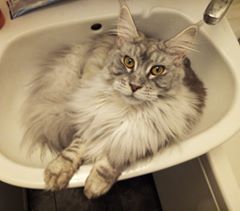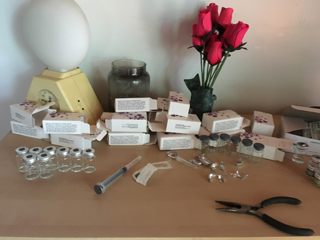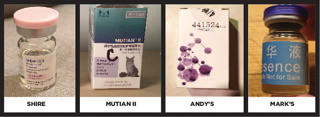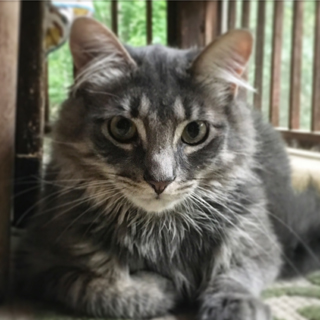 Listen to this story.
Listen to this story.
This is the first of two parts. Read part 2.
Estonia cat

Facebook photo
This kitten died in June from feline infectious peritonitis, or FIP, hours after her owner in Estonia made a plea for black market medications on a closed Facebook group.
On a Friday in early June, the owner of a kitten in Estonia with feline infectious peritonitis, or FIP, posted a plea to a closed Facebook group: Could anyone in Sweden, Finland, Latvia or Lithuania spare two doses of GS-441524? Her order of the antiviral compound made in China had been waylaid; she felt sure her cat would not survive the weekend without it.
A few members scrambled to find surplus vials of "GS" in the region. But the effort was too late. Seven hours later, the cat owner posted: "Thank you all for your support. The heaven[s] have a new beautiful and sweet angel."
Stories like this one are common for the FIP Warriors Facebook group, which until early August called itself FIP Warriors Using GS. Its members are owners of cats diagnosed with or suspected of having FIP, an atypical and usually deadly immune response to infection by feline coronavirus. FIP kills around 1.3% of cats worldwide, according to Dr. Niels Pedersen, a respected FIP researcher. FIP Warriors is not the only FIP-related group on Facebook, but it's the only one to have referenced an unapproved treatment in its name.
The group reflects what is shaping up to be a watershed moment in the fight against this dread condition, which has been considered incurable. That's changing. Within the past four years, GS-441524 (patented by Gilead Sciences) and another antiviral agent, GC376 (patented by Kansas State University), have been shown to reverse the progression of FIP in clinical trials involving several dozen infected cats. The agents interfere with the virus's ability to hijack the body's immune system.
Although neither compound has been approved for commercial use by the U.S. Food and Drug Administration or any regulatory agencies abroad, reports of cured cats on social media are driving developments beyond the FDA's reach. In China, where cat ownership and cases of FIP are on the rise, entrepreneurs have begun producing versions of these antivirals. Over the past year, the compounds have made their way to pet owners around the world via online chemical companies and networks of sellers facilitated by online cat owner groups. Buyers' stories of cats recovering following treatment add fuel to the market — offering hope and posing risks for owners of FIP-affected cats and creating challenges for veterinarians.
Pedersen, who conducted the GS-441524 trials at the University of California, Davis, School of Veterinary Medicine, posted an article on websites for the UC Davis Center for Companion Animal Health and SOCK FIP (Save our Cats and Kittens from Feline Infectious Peritonitis) early this year, alerting colleagues about the existence of Chinese-made compounds.
As he sees it, the problem is primarily an issue of patent rights to these compounds, not their efficacy. "I know that hundreds, and perhaps thousands, of cats with FIP have been treated with non-approved GC376 and GS-441524 … and that many cats have been cured of their infection with no more side effects than we described in our published field trials," Pedersen wrote in an email interview with the VIN News Service.
But that could change tomorrow, he warns. "Like all black-market drugs, there are bound to be suppliers that are willing to sell drugs that are less than pure or not fully biologically active to desperate consumers. The only truth is 'caveat emptor' — let the buyers be aware."
Pedersen said he hears from several owners of cats suspected of having FIP every day. He doesn't advise them about whether to buy the drugs, but he answers questions about his research because he feels "some duty to make sure that these drugs are used properly."
For veterinarians, the current situation poses legal and ethical quandaries. Recommending or administering the unapproved drugs from such sources could put a veterinarian's license in jeopardy or open them to client complaints if treatment should fail or go wrong. "[I]t pits doing nothing against our need to provide the best treatments for our patients," Pedersen said.
Difficult to diagnose, nearly always fatal
FIP was first identified as a clinical entity in the 1950s. It has since become the most researched infectious disease of cats, according to Pedersen. FIP is triggered by mutations that occur in a ubiquitous and otherwise unimportant pathogen called feline enteric coronavirus (FECV). These mutations allow FECV to escape mature epithelial cells in the lower intestine and infect the most basic cell of the immune system, the macrophage. This new macrophage-infecting virus is known as FIP virus, or FIPV.
"About one in 10 cats exposed to this mutant virus will go on to develop FIP after a subclinical period ranging from days to a year or more," Pedersen said. "FIP is fatal in virtually all cases if left to run its normal course." It is considered the leading cause of infectious death among young cats from foster/rescues, shelters and catteries.
There are two forms of FIP: wet and dry. Cats may initially present with one form and later develop the other. In wet FIP, fluid resulting from inflammation accumulates most commonly in the abdomen, less commonly in the thorax and occasionally in other body spaces such as the pericardium or scrotum. In dry FIP, the cat develops tumor-like lesions in the abdomen, thorax, eyes (ocular disease) and/or brain (neurological disease). Early clinical signs of FIP include fever, loss of appetite, weight loss and depression. In the case of neurological FIP, cats may develop a lack of coordination, seizures and dementia. Ocular disease can cause inflammation, discoloring or clouding of the eyes, impairing vision.
FIP is widely considered difficult to diagnose, especially in dry form, which can be confused with certain cases of toxoplasmosis, fungal infections or lymphoma. Pedersen, though, maintains that FIP is not hard to diagnose and notes that the conditions with which it might be confused occur more rarely than FIP. Still, there is no single test that can diagnose every case of FIP with complete sensitivity and specificity. Therefore, the diagnosis is often made through the sum of clues from history, symptoms, physical exam and various tests including examination of effusions and blood tests.
Many cats with FIP are euthanized. Others are given symptomatic treatment with the slight hope that the cat's own immune system might, if given the chance, quell the infection. Thus far, only GC376 and GS-441524, targeted antiviral therapies, reportedly have cured FIP in some cats. These hard-to-remember names are assigned by the discoverers, and have no particular meaning. Among those in the FIP world, the compounds generally are referred to as GS and GC.
GS and GC are small molecules that easily pass from the bloodstream into normal and infected cells. Once in infected cells, they target specific viral proteins that control virus replication. GS inhibits the formation of viral RNA at its earliest point, while GC inhibits the formation of mature viral proteins at a later stage. In trials so far, GS has been shown to be the more effective.
The internet fills a gap
Mutian treatments 320

Spent vials of GS, a syringe, and pliers for pulling the metal bands off the vials hint at the effort of treating an FIP-infected kitten at home.
Faced with a grim diagnosis and poor treatment options, owners often turn to the internet when they get the bad news.
One New York cat owner said she "Googled like crazy" after her gray long-haired cat, Charlie, was diagnosed with FIP in January. (For this article, the owner adopted the pseudonym Kate for herself and changed her cats' names, as well, to guard against potential repercussions for her use and promotion of unapproved drugs.) Kate quickly learned about the new antiviral treatments that have been used in research studies by U.S. veterinary scientists. By the time she joined a closed Facebook group called FIP Fighters, Charlie was feverish, wobbly on his legs and having seizures. Her first question to the group was, where could she find GS?
At first, she did not get answers. At the time, FIP Fighters did not condone the use of unapproved treatments and banned conversations about their use. Then, one member contacted Kate via direct message. The member sent by overnight post a vial of her own GS so Kate could start treating Charlie immediately. She also put her in touch with a GS supplier.
With one injection of GS, Charlie's two-week fever broke, and he never had another seizure, Kate said. "Honest to God, it is so miraculous when it works."
Kate ordered 10 vials of injectable GS for the 12-week treatment followed in the trials. "While I waited for those, I had no idea if I just launched several thousand dollars out into the ether never to be seen again," she said. "But one of the craziest things about this whole experience is, there hasn't been a single incident of not receiving what you ordered, or money being stolen. Everybody has been so helpful and honest throughout this entire process."
The price of GS varies depending on the source and the form. FIP Warriors talk about spending thousands, even tens of thousands, of dollars for the treatment. During the course of the summer, several sources reported that the price was dropping as more owners purchased GS.
Charlie developed the neurological version of FIP, which has been less responsive to treatment with GS, and relapsed after 30 days. Following recommendations she found in Pedersen's research, Kate increased the dosage and reset the clock on Charlie's 12-week regimen of daily injections. About 10 days after Charlie was diagnosed, his littermate Phoebe developed symptoms of wet FIP. Without pausing for a diagnosis, Kate immediately put her on GS. Phoebe recovered within a week, although Kate kept her on the full recommended course.
Kate was among the early members of FIP Warriors, which launched in March as a GS-friendly alternative to FIP Fighters. The latter group has since revised its policy, and this month began referring pet owners seeking information about the unapproved treatments to FIP Warriors.
FIP Warriors has grown to more than 2,000 members in five months. They learn how and where to buy GS and GC. They post videos of skinny kittens playing, eating and jumping for the first time in weeks. They ask for and give advice on dosages, diagnoses, nutrition and giving injections. They share bloodwork and treatment plans, and they condole with those who lose their pets along the way, which is still frequent.
Some veterinarians and cat owners compare the situation to the early days of the HIV/AIDS epidemic, when terminally ill patients joined buyers clubs to get access to foreign versions of unapproved antiviral drugs and treatments smuggled into the country. Beyond being a source for needed medications, the buyers clubs became hubs for support, treatment education and advocacy.
The China connection
Although GS and GC are also not approved in China, Pedersen said many veterinarians there are using the treatments "without hesitation." Chinese entrepreneurs are producing versions of GS and GC, in part, for a home audience. Cat ownership is booming in China, especially pedigreed cats, which contract FIP at greater rates than non-pedigreed cats. Research has shown that inbreeding is an important genetic cause of decreased resistance to FIP.
American veterinarians working in Hong Kong say that they know of veterinarians using GC and GS in mainland China or managing cases for clients treating cats on their own in Hong Kong. Some versions of the antivirals are sold directly to the public on Taobao, an online shopping website that resembles Amazon.
GS and GC are fairly easy to replicate. Patents are free to review and contain chemical structure; and scientific journals often require that chemical structure and formula be included in articles, Pedersen said. "Many papers also include detailed descriptions of the methodology used to synthesize a given compound," he said. "The companies that make these drugs are apparently under no meaningful legal restraints in making and selling them."
Brands

Members of FIP Warriors Facebook group usually purchase one of four FIP treatments made in China.
Some pet owners buy China-made GS through intermediaries with the help of others in the FIP network. In early August, four GS "brands" were affirmed by FIP Warriors. They are known as Mutian II, Mark's, Andy's and Shire. According to the group's administrator, random samples of all four were tested in a lab in June, and found to match the concentrations and biological activity advertised by the suppliers.
A member of the FIP Warriors Facebook group connected VIN News with someone who claimed to be a representative of Mutian Biotechnology in China. Writing via Facebook Chat, he asked to be identified as Lu. VIN News was not able to independently verify Lu's identity or connection to Mutian or to find information about the company.
"We spend a ton of money to do the research for the FIP medication," Lu wrote. "At this point, the company doesn't have any profit. We are trying to save cats as many as possible."
He claimed that Mutian's treatment, which is also called Mutian, has cured more than 2,000 cats in China, the U.S., Europe, Australia, Korea and Japan so far. "We promise if the cat cannot be cured, we will provide free medication until the cat is cured," he said.
Lu took issue with the term "black market" to describe the sale and distribution of Mutian. While the product is referred to as GS by cat owners on FIP Warriors, Lu claims that the active ingredients are "completely different from the molecular formulas in the now published GS patent." He said the company's research is based on GS research, and the company will disclose the formula after its own patent is approved.
In addition, Lu said, the company's manufacturing is approved by the Chinese government, and offered to provide a "certificate" from China's equivalent of the FDA, as well as reports. However, Lu did not provide the certificate or reports to VIN News, despite repeated requests.
Lu also said that the company is working on approval through the FDA and plans to open "Mutian centers" in the U.S.
When asked about FDA review, Juli Putnam, a spokesperson in the FDA Center for Veterinary Medicine, responded, "The FDA generally cannot confirm or deny the existence of — or comment on — any pending investigational new animal drug (INAD) files or pending new animal drug applications (NADA) that have not been publicly disclosed by the sponsor."
In addition to treatments purchased through intermediaries, GS and/or GC has been for sale in powder form "for research purposes only" on the websites of at least four chemical companies. Two sources identified by people in the FIP community are DC Chemicals in Shanghai and Glixx Laboratories in Massachusetts.
In early June, DC Chemicals' order page for GS featured this note: "GS-441524 is for research use only, not for human or veterinary use! Please confirm the use of the product before you order it. DC Chemicals Limited will not be responsible for any issue as a result of any other purpose of the product by the customer… Buyer must be a professional from a company or research organization, who received enough training and knows how to use the product since we will not provide how-to-use instruction."
After VIN News asked DC Chemicals about its procedure for verifying that buyers are researchers, a representative of the company said GS and GC had been removed and would be discontinued out of concern that a mention in this story would cause pet owners to contact the company to buy either for personal use.
An owner of a kitten that was diagnosed with wet FIP earlier this year ordered powdered GC from Glixx. He is not a researcher and he wasn't asked for proof that he was. "We know we are playing a game when it comes to ‘research-uses-only,'" he said. "You tongue-in-cheek acknowledge that you are ‘doing research.' "
Furthermore, a representative of the company offered advice to the owner on how to dilute the compound — a basic skill that would seem unnecessary to teach a legitimate researcher.
A spokesperson at Glixx Laboratories said the company launched in 2014 to provide newly discovered chemical compounds for researchers at institutions, pharmaceutical companies, universities and the like around the world. Glixx carries more than 10,000 small drug-like molecules for sale, including GC376. He said the FIP treatment would not be sold for personal use, the website explicitly says it should not be purchased by pet owners to treat their own cats, and that buyers take full responsibility for how they use the compounds.
The owner who purchased GC376 requested VIN News not use his name because he was purchasing illegal drugs. But his concern might be unnecessary. Siobhan DeLancey, a spokesperson in the FDA Center for Veterinary Medicine, said the agency is primarily interested in parties that sell unapproved drugs, not end users.
For the FDA, GS and GC fall into an unusual category. They are not technically "counterfeit drugs," which are knockoffs of approved drugs. Nor are the versions produced in China part of any research trial in the U.S., which has its own series of rules and controls at the FDA. They are simply "unapproved drugs." Under U.S. law, it makes no difference where they are produced — they are illegal.
"The FDA's Center for Veterinary Medicine has some awareness of these drugs but has limited information regarding how veterinarians or pet owners are obtaining them," Putnam of the FDA said. VIN News knows of no veterinarians in the U.S. who are purchasing GS or GC directly.
Street research
Charlie cat 320

Charlie has the hard-to-reverse neurological form of FIP. After about 16 weeks of injectable Mutian, he relapsed. Recently, his owner started him on the pill form, which became available this summer for the first time.
Meanwhile, the public experiment with unapproved GS and GC is fast eclipsing what has been learned in formal clinical trials in the U.S. A few weeks ago, Kate's kitten, Charlie, developed a fever, became lethargic, acted like he was in pain and began hiding. He was relapsing at the tail end of a 12-week round of a higher-concentration GS.
He had been getting harder and harder to inject, Kate reported by email. "He would cry and the medication would mostly leak out. I felt like a complete failure, and like I'd tortured him for the last five months with no successful outcome other than keeping him alive. That's something but not the same as curing him."
Despite her anxiety, she is not giving up. In late July, she began giving Charlie Mutian's new pill version of GS, which became available in June. She said he seems to be improving.
Pedersen said he has no experience with the oral form of GS, which he calls a "Chinese invention." But he wants to know what owners in the field are learning. "Without this source of drugs, the research we have completed would still be contained on the paper pages of our publications," he said.
While he neither encourages nor discourages pet owners from buying the antivirals, he strongly encourages members of FIP Warriors who do use the drugs to gather as much data as they can, especially in the case of cats who, like Charlie, have the neurological version.
They are doing just that. FIP Warriors has created a subgroup for pet owners who want to keep track of and share the results of each step of their cat's treatment. For the moment, this grassroots effort may be the closest thing to a field trial for FIP drugs going on in the country.
Part 2: Legal treatment for cat disease known as FIP still years away
Correction: The caption for the photo of spent GS vials originally misidentified the source as Mutian.